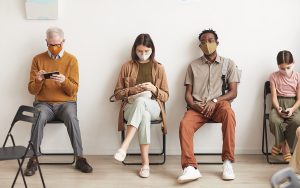Should you go to the Emergency Room, Urgent Care or Walk-in Clinic?

Shawn Evans MD
Emergency Medicine
Scripps
Differences between emergency and non-emergency care
All too often, illness or injury appears out of the blue: You wake up in the middle of the night with intense abdominal pain. You stumble while carrying groceries up a flight of stairs, and cannot put weight on your swollen ankle. Or your baby spikes a high fever on the weekend.
When these situations occur, we’re often faced with uncertainty about where to go for care, especially if the symptoms seem severe and our regular doctor’s office is closed.
While the answer is not always simple, knowing the difference between a walk-in clinic, an urgent care center and a hospital emergency room can make a huge difference, especially if you have a medical emergency.
• When to go to the ER
• When to call 911
• When to go to urgent care
• When to go to a walk-in clinic
• How to be prepared
What’s the difference between ER, urgent care and walk-in clinic?
“Recognizing the differences between ‘emergency’ and ‘urgent’ care can be confusing, because both terms imply there is a medical need that needs to be addressed quickly,” says Shawn Evans, MD, an emergency medicine physician at Scripps Memorial Hospital La Jolla.
“However, there are distinct differences between hospital emergency rooms, traditional urgent care centers or walk-in clinics, including the level of care that can be provided at each.”
Hospital emergency departments provide medical care at any time, day or night. Unlike urgent care centers or walk-in clinics, they are equipped and staffed to handle the most complex or critical needs, including life- and limb-threatening situations ranging from heart attack and stroke to traumatic injuries following a car accident.
Urgent care or walk-in clinics help fill a vital gap when you become sick or injured, but your regular doctor is not available and you can’t wait for an appointment.
“If your sudden illness or injury is something you would normally feel comfortable addressing with your primary care doctor, then an urgent care center or walk-in clinic setting is probably more appropriate than the emergency room,” says Dr. Evans.
When to go to the ER
Certain medical conditions are considered emergencies because they can require rapid or advanced treatments, including surgery, that are only available in a hospital setting.
Symptoms that are best evaluated in an emergency room include:
• Chest pain or difficulty breathing
• Weakness/numbness on one side
• Slurred speech
• Fainting/change in mental state
• Serious burns
• Head or eye injury
• Concussion/confusion
• Broken bones and dislocated joints
• Fever with a rash
• Seizures
• Severe cuts that may require stitches
• Facial lacerations
• Severe cold or flu symptoms
• Vaginal bleeding with pregnancy
“Trust your gut,” says Dr. Evans. “If your personal instinct or your motherly intuition tells you it’s serious, don’t hesitate — go to the nearest emergency room.”
Scripps emergency rooms are located in Encinitas, La Jolla (inside Prebys), San Diego (in Hillcrest) and Chula Vista.
When to call 911
Even if it is clear that you or your loved one needs emergency care, you may not be sure whether to drive yourself to an emergency room or call 911.
“Many people are nervous about calling 911, but it’s better to be safe than sorry,” says Dr. Evans. “You should never drive yourself if you are having severe chest pain or severe bleeding, if you feel like you might faint or if your vision is impaired. When in doubt, please call 911 — what matters most is that you get to the emergency room quickly and safely.”
In case of a heart attack or stroke, calling or having someone call 911 for an ambulance is always the right decision. Paramedics often can begin delivering life-saving treatment on the way to the hospital.
When to go to urgent care
Urgent care is not emergency care. Urgent care centers are same-day clinics that can handle a variety of medical problems that need to be treated right away, but are not considered true emergencies.
“Many people use the emergency room as a place to receive after-hours care for minor illnesses or injuries without realizing they have another option,” says Dr. Evans.
Symptoms that can be evaluated and treated at an urgent care clinic include:
• Fever without a rash
• Vomiting or persistent diarrhea
• Abdominal pain
• Wheezing or shortness of breath
• Dehydration
• Moderate flu-like symptoms
• Sprains and strains
• Small cuts that may require stitches
Call your primary care doctor’s office, in case you can get a same-day appointment, if your symptoms come on gradually or if you already know your health problem. You may have repeat urinary tract infections,for example. You may recognize that your child has an ear infection.
It’s worth calling your primary care doctor because he or she knows your health history, including what treatments have worked best in the past and whether you have other medical conditions that need to be taken into consideration.
An urgent care clinic is not a substitute for your primary care physician, but it is a great resource when you need care but can’t get in with your doctor.
Scripps offers urgent care services for children and adults — seven days a week — at Jefferson (in Oceanside), Rancho Bernardo and Torrey Pines.
When to go to a walk-in clinic
Walk-in clinics are a good option for when you are not feeling well, but it’s not serious enough for the emergency room or urgent care.
Walk-in clinics offer fast, convenient access to medical care. No appointment is necessary. They are generally staffed by nurse practitioners and physician assistants.
Walk-in clinics, including Scripps HealthExpress, address the most minor of ailments, such as:
• Painful urination
• Rashes without fever
• Mild flu-like symptoms
• Cough and congestion symptoms
• Sore throat
• Ear pain
• Eye redness, discharge or itchiness
Many walk-in clinics also provide sports physical and vaccines.
Scripps offers HealthExpress care at multiple Scripps Clinic and Scripps Coastal locations throughout San Diego County.
Join the waitlist for Scripps HealthExpress by calling 858-554-7439 or by adding your name to the waitlist online.
How to prepare for a medical visit
Wherever you go for your medical visit, it’s a good idea to bring a list of medications you take, including over-the-counter medicine, vitamins and supplements, how much you take and how often.
Also keep with you a list of any allergies (including medication allergies) and any previous medical procedures or surgeries you’ve had, including the dates they were performed and the names of the physicians or surgeons who treated you.
“Especially in an emergency setting, it can be very helpful for the physician treating you to know whether you’ve had operations in the past, or whether you’re allergic to medications or anesthesia,” says Dr. Evans.
